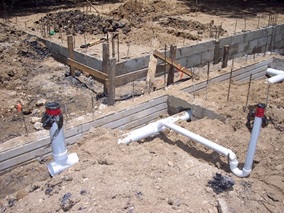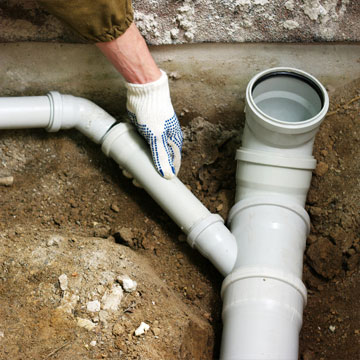The Basics to Your Home's Plumbing System Anatomy
The Basics to Your Home's Plumbing System Anatomy
Blog Article
Were you trying to find additional info around Plumbing Installation 101: All You Need to Know?

Recognizing exactly how your home's pipes system works is vital for every house owner. From providing clean water for drinking, cooking, and bathing to safely getting rid of wastewater, a properly maintained pipes system is crucial for your family's health and convenience. In this thorough guide, we'll discover the detailed network that comprises your home's pipes and offer tips on upkeep, upgrades, and handling typical concerns.
Intro
Your home's pipes system is more than simply a network of pipelines; it's a complex system that guarantees you have access to tidy water and effective wastewater removal. Recognizing its elements and exactly how they interact can assist you avoid costly repairs and make certain every little thing runs smoothly.
Fundamental Elements of a Pipes System
Pipes and Tubes
At the heart of your pipes system are the pipelines and tubing that lug water throughout your home. These can be made from various products such as copper, PVC, or PEX, each with its benefits in terms of longevity and cost-effectiveness.
Components: Sinks, Toilets, Showers, and so on.
Fixtures like sinks, commodes, showers, and bathtubs are where water is made use of in your home. Understanding just how these fixtures link to the plumbing system aids in detecting issues and intending upgrades.
Valves and Shut-off Points
Shutoffs control the flow of water in your plumbing system. Shut-off valves are critical during emergencies or when you require to make fixings, permitting you to isolate parts of the system without interfering with water flow to the entire house.
Water System
Key Water Line
The major water line links your home to the local water supply or a personal well. It's where water enters your home and is dispersed to various fixtures.
Water Meter and Stress Regulator
The water meter measures your water use, while a stress regulatory authority ensures that water moves at a safe pressure throughout your home's plumbing system, protecting against damage to pipelines and components.
Cold Water vs. Hot Water Lines
Recognizing the distinction between cold water lines, which provide water directly from the primary, and warm water lines, which carry heated water from the water heater, assists in fixing and planning for upgrades.
Drainage System
Drain Pipes Water Lines and Traps
Drain pipes bring wastewater away from sinks, showers, and commodes to the drain or sewage-disposal tank. Traps avoid drain gases from entering your home and likewise catch particles that could create blockages.
Air flow Pipelines
Air flow pipelines permit air into the drainage system, avoiding suction that can reduce drainage and create traps to empty. Proper air flow is crucial for keeping the honesty of your plumbing system.
Relevance of Appropriate Drain
Making certain correct drainage prevents backups and water damages. Frequently cleansing drains and maintaining traps can prevent costly fixings and expand the life of your pipes system.
Water Heater
Sorts Of Hot Water Heater
Water heaters can be tankless or standard tank-style. Tankless heaters warm water as needed, while tanks store heated water for prompt usage.
How Water Heaters Connect to the Pipes System
Comprehending how hot water heater link to both the cold water supply and hot water distribution lines aids in diagnosing problems like not enough hot water or leaks.
Upkeep Tips for Water Heaters
Regularly purging your water heater to remove debris, checking the temperature level setups, and evaluating for leaks can expand its life expectancy and boost power performance.
Typical Pipes Concerns
Leaks and Their Reasons
Leaks can happen due to maturing pipes, loose fittings, or high water pressure. Dealing with leakages immediately protects against water damages and mold development.
Clogs and Obstructions
Clogs in drains and bathrooms are commonly brought on by flushing non-flushable products or a buildup of oil and hair. Utilizing drain screens and bearing in mind what decreases your drains can protect against obstructions.
Indicators of Pipes Issues to Watch For
Low water pressure, slow drains pipes, foul odors, or abnormally high water expenses are indicators of potential plumbing problems that should be dealt with without delay.
Pipes Upkeep Tips
Routine Assessments and Checks
Arrange yearly plumbing inspections to catch problems early. Seek signs of leaks, rust, or mineral buildup in faucets and showerheads.
Do It Yourself Maintenance Tasks
Straightforward jobs like cleaning tap aerators, looking for toilet leaks using color tablet computers, or protecting subjected pipes in chilly environments can prevent significant pipes issues.
When to Call a Professional Plumbing Technician
Know when a pipes problem calls for expert competence. Trying intricate repair services without proper understanding can bring about even more damage and greater repair work costs.
Updating Your Pipes System
Reasons for Updating
Upgrading to water-efficient fixtures or changing old pipes can boost water quality, reduce water bills, and enhance the value of your home.
Modern Pipes Technologies and Their Benefits
Discover innovations like clever leak detectors, water-saving bathrooms, and energy-efficient hot water heater that can save money and minimize ecological effect.
Price Factors To Consider and ROI
Determine the upfront expenses versus long-term savings when taking into consideration pipes upgrades. Numerous upgrades pay for themselves with minimized utility expenses and less repairs.
Environmental Influence and Preservation
Water-Saving Components and Home Appliances
Mounting low-flow taps, showerheads, and commodes can dramatically minimize water usage without giving up efficiency.
Tips for Minimizing Water Use
Easy habits like taking care of leaks without delay, taking shorter showers, and running full loads of washing and dishes can preserve water and lower your energy costs.
Eco-Friendly Pipes Options
Take into consideration lasting pipes materials like bamboo for flooring, which is durable and environment-friendly, or recycled glass for counter tops.
Emergency situation Readiness
Steps to Take Throughout a Plumbing Emergency
Know where your shut-off valves lie and how to switch off the water in case of a ruptured pipeline or major leak.
Importance of Having Emergency Calls Useful
Maintain contact info for local plumbers or emergency solutions readily offered for quick action during a pipes situation.
DIY Emergency Situation Fixes (When Appropriate).
Short-term fixes like making use of duct tape to spot a leaking pipeline or putting a pail under a dripping faucet can reduce damages till a specialist plumbing professional shows up.
Final thought.
Understanding the anatomy of your home's plumbing system encourages you to keep it properly, saving money and time on repair services. By following routine maintenance regimens and staying notified regarding modern-day pipes modern technologies, you can guarantee your pipes system runs efficiently for many years ahead.
Understanding Your Home Plumbing System: A Comprehensive Guide
Plumbing System: The Lifeline of Your Home
At its core, the plumbing system is designed to perform two primary functions: bring fresh water into your home and remove wastewater. The system is a network of pipes, fixtures, and other components that transport water and sewage. Residential plumbing systems include potable water supply lines, drain-waste-vent (DWV) systems, and various plumbing fixtures that make water use in daily tasks possible.
Key Components:
Water Supply: This part of your plumbing system brings municipal water into your home, passing through the main water supply line. It s responsible for supplying all water needs, from drinking to bathing.
Drainage System: It carries waste and water away from your home to the sewer or septic system. This system includes all the piping within your home that leads to external sewage or septic systems.
Vent System: An essential yet often overlooked component, the vent system allows sewer gases to escape and lets air into the drainpipes, ensuring water and waste move correctly through the system.
Fixture: More Than Just Taps and Toilets
Plumbing fixtures are the most interactive parts of the plumbing system, including faucets, showers, toilets, and sinks. Each fixture is connected to the plumbing system and plays a role in either the delivery of freshwater or the disposal of waste and wastewater.
Types of Fixtures:
Faucets and Sinks: Used for washing hands, dishes, and other daily water needs.
Toilets: Dispose of human waste through the sewage system.
Bathtubs and Showers: Provide bathing facilities, requiring both hot and cold water supply.
Water Supply: The Source of Life
The water supply system is a critical component, ensuring that potable water is available throughout your home for various uses, including drinking, cooking, and cleaning. This system consists of pipes that distribute water to different parts of the house, controlled by valves to regulate the water flow.
Types of Plumbing: Materials and Methods
Various types of plumbing systems and materials are used in residential settings, each with its advantages and applications. From copper and PVC pipes for water supply to cast iron and ABS for drainage, the choice of materials can impact the longevity and efficiency of your plumbing system.
https://intownplumbingtx.com/articles/home-plumbing-system-guide/

Understanding Your Home Plumbing System: A Comprehensive Guide
Plumbing System: The Lifeline of Your Home
At its core, the plumbing system is designed to perform two primary functions: bring fresh water into your home and remove wastewater. The system is a network of pipes, fixtures, and other components that transport water and sewage. Residential plumbing systems include potable water supply lines, drain-waste-vent (DWV) systems, and various plumbing fixtures that make water use in daily tasks possible.
Key Components:
Water Supply: This part of your plumbing system brings municipal water into your home, passing through the main water supply line. It s responsible for supplying all water needs, from drinking to bathing.
Drainage System: It carries waste and water away from your home to the sewer or septic system. This system includes all the piping within your home that leads to external sewage or septic systems.
Vent System: An essential yet often overlooked component, the vent system allows sewer gases to escape and lets air into the drainpipes, ensuring water and waste move correctly through the system.
Fixture: More Than Just Taps and Toilets
Plumbing fixtures are the most interactive parts of the plumbing system, including faucets, showers, toilets, and sinks. Each fixture is connected to the plumbing system and plays a role in either the delivery of freshwater or the disposal of waste and wastewater.
Types of Fixtures:
Water Supply: The Source of Life
The water supply system is a critical component, ensuring that potable water is available throughout your home for various uses, including drinking, cooking, and cleaning. This system consists of pipes that distribute water to different parts of the house, controlled by valves to regulate the water flow.
Types of Plumbing: Materials and Methods
Various types of plumbing systems and materials are used in residential settings, each with its advantages and applications. From copper and PVC pipes for water supply to cast iron and ABS for drainage, the choice of materials can impact the longevity and efficiency of your plumbing system.
https://intownplumbingtx.com/articles/home-plumbing-system-guide/
We hope you enjoyed our post on Anatomy of a House: Understanding the Components. Thanks for spending some time to browse our piece of content. I beg you take the time to share this entry if you enjoyed it. Thanks so much for going through it.
Get Quote Now Report this page